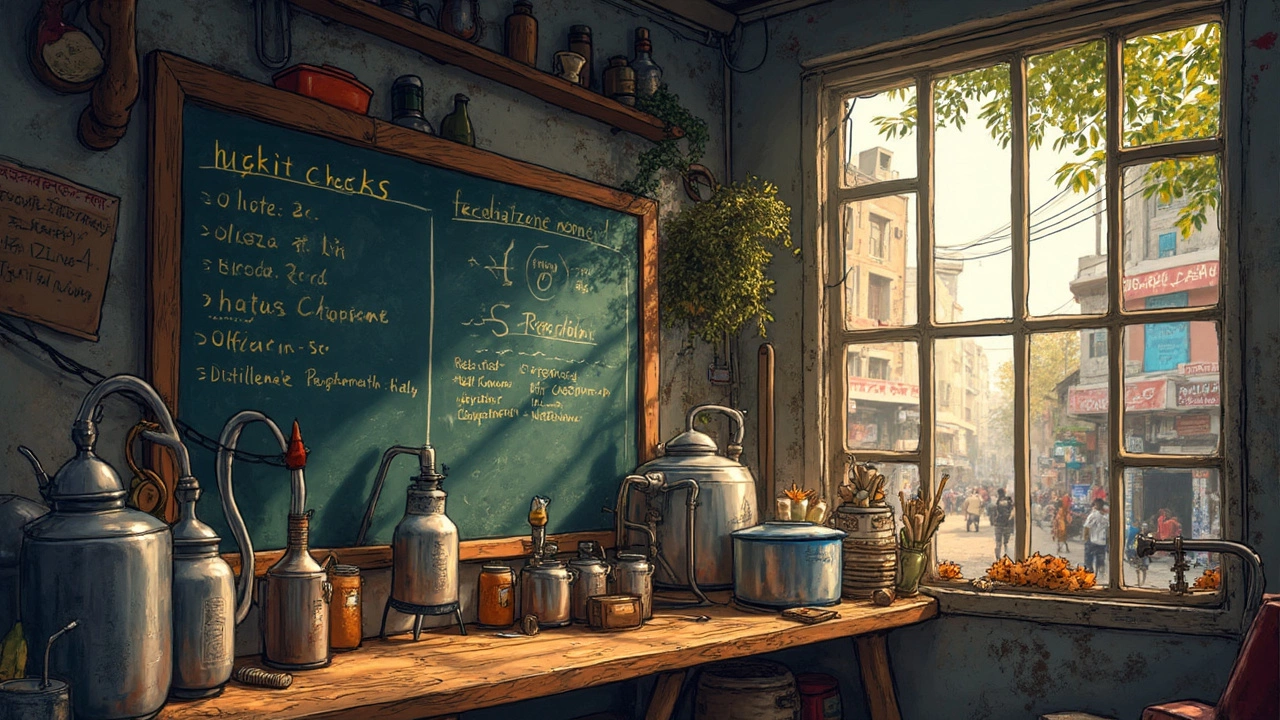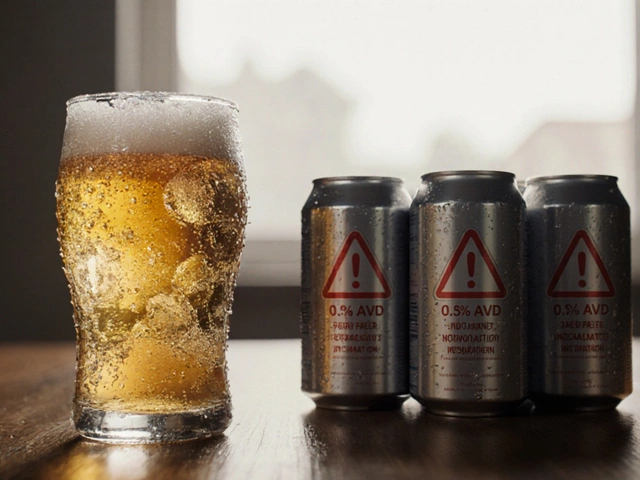
Ever wonder why your neighbor can whip up a batch of homebrew beer but isn't sporting a homemade whiskey stash? It boils down to a mix of history, law, and a bit of science. In most places, you can brew your beer, but that whiskey is off-limits without a permit. So, let's delve into why that is.
First off, the law is your main gatekeeper here. It all stems back to the prohibition era, when tight regulations were placed on alcohol production. Brewing beer at home is permissible because it's classified differently from liquor. Beer is fermented, while liquor gets its kick from distillation, a trickier (and legally tougher) process.
Beyond just the legal stuff, safety is a top concern. Distillation can lead to all sorts of hazards if you don't know what you're doing—explosions, for example, if you’re being dramatic, but more practically, toxic substances could make their way into your end product if not managed correctly. Play it safe and maybe just celebrate with that IPA you made yourself.
- The Basics of Homebrewing
- Legal Landscape: Beer vs. Liquor
- Safety Concerns
- Equipment and Techniques
- The Homebrewer's Toolkit: Tips and Tricks
The Basics of Homebrewing
Dipping your toes into home brewing can seem a bit overwhelming at first, but it's actually a lot simpler than you'd think. At its core, homebrewing beer involves fermenting a mixture of malted barley, water, hops, and yeast. It's a fun way to experiment and get a little crafty in the comfort of your own home.
Essential Ingredients
Let's break down the main ingredients you'll need:
- Malted Barley: This is the backbone of your beer. It gives the drink its body and sweetness.
- Water: Makes up the majority of your beer, so good quality water is essential.
- Hops: These little guys add bitterness and aroma to balance the sweetness of the malt.
- Yeast: This is where the magic happens. Yeast ferments the sugars from the malt to produce alcohol.
The Basic Equipment
Before you start brewing, you'll need some basic equipment. Don't worry, it won't break the bank:
- Fermenter: A large, food-grade plastic or glass container to ferment your beer.
- Airlock: It lets gases escape during the fermentation process without letting any nasties in.
- Bottles: You'll need something to store your finished beer in. Standard beer bottles work fine.
- Sanitizer: Keeping everything clean is crucial to avoid infection ruining your batch.
Brewing Steps
Homebrewing typically follows these basic steps:
- Mash: Heat water and malted barley to extract the sugars.
- Boil: Add the hops and boil the mixture to break down the sugars and add flavor.
- Fermentation: Once cooled, add yeast and let the mixture ferment for a couple of weeks.
- Bottling: Add priming sugar, transfer to bottles, and seal them. Let them carbonate for another week or two.
Getting Started
Homebrewing is a learning process. Mistakes might happen, but each batch gets better as you experiment and learn. Most home brewing kits available today make it easy for beginners by providing both the ingredients and instructions you need to succeed. So grab a kit, follow some simple steps, and enjoy the taste of beer you brewed yourself!
Legal Landscape: Beer vs. Liquor
When it comes to homebrewing, the legal landscape splits like a fork in the road between brewing beer and distilling liquor. So why is it okay to brew beer at home but a hard stop when it comes to distillation? Let's break it down.
Beer: A Brewing Freebie
Brewing beer at home generally falls under federal laws in many countries that give hobbyists some leeway. For instance, in the United States, the law passed in 1978 allows adults to brew up to 100 gallons of beer per year per adult, maxing out at 200 gallons per household. The UK has its own similar relaxed laws, and many places in Europe don’t fuss much about home-brewed beer as long as the amount is for personal consumption and not commercial.
But why the freedom for beer? One simple reason is its history and basic production nature. Homebrewing is seen as an ancient tradition, and governments like to leave it in the hands of hobbyists, within reason. This vibe is like a community-building craft rather than a commercial endeavor.
The Distilled Stalemate
On the flip side, liquor distillation takes more legal muscle to get moving. In places like the U.S. and Scotland, you need a dear old distiller's license to make liquor legally at home. Despite home-distilling fascinated folks frequently lobbying for law ease, regulations haven't quite budged.
"The rules on home distillation are designed to protect public safety and ensure accurate taxation," says Sarah Johnson of the Alcohol and Tobacco Tax and Trade Bureau.
Liquor's legal complexities root from both safety hazards and tax considerations, which differs from the relatively safer brewing process of beer. The equipment used in distillation can lead to dangerously high alcohol concentrations and even explosions, a risk you don't run with malt and hops.
| Pints | Gallons |
|---|---|
| 100 | Approx. 12 |
| 200 | Approx. 24 |
So, while your brewing beer experimentations can mostly sail smoothly under the radar, distilling at home could require passing through regulatory hoops—and the safety risks don't help its case. The legal landscape keeps beer and liquor on distinctly different paths, all for some practical reasons.

Safety Concerns
When it comes to making your own booze at home, there’s a world of difference between home brewing beer and trying your hand at distilling liquor. While beer brewing is generally safe and straightforward, creating liquor involves some serious safety risks that you need to be aware of.
Explosive Potential
One of the biggest safety concerns with distilling is the risk of explosion. Distillation involves separating alcohol from a liquid mixture using heat, which can create flammable vapors. If these vapors build up, they're a bomb waiting to happen. In contrast, brewing beer doesn’t go near these kinds of hazards—hence why you can find those brewing kits for beer just about anywhere.
Toxicity and Health Risks
If not done correctly, distillation can produce harmful substances like methanol, which is downright toxic. Methanol ingestion leads to severe health issues, including blindness or even death. Beer brewing, on the other hand, doesn’t carry these risks because the fermentation process doesn't generate methanol in concerning amounts.
Equipment Hazards
Thought setting up your home brewing kit was complex? Distillation equipment is even more complicated and can be dangerous if improperly handled. Hot surfaces, pressurized systems, and intricate components make it a challenging and risky endeavor for the inexperienced.
The Role of Legal Regulations
Because of these risks, most places have strict laws regulating or outright banning home distillation. Meanwhile, fewer legal hurdles exist for brewing beer, which is a more regulated and safer hobby. Always check local regulations before starting any homebrew project.
In a nutshell, the key differences boil down to safety and legality, making beer the clear choice for your at-home brewing adventures. But hey, it’s not all bad—experimenting with different beer styles can be loads of fun!
Equipment and Techniques
Diving into the world of home brewing means getting your hands on the right gear. Thankfully, it's not too daunting if you know what you're looking for. So, let's break it down to essentials.
Must-Have Equipment
- Fermentation Vessel: This is where the magic happens. It’s usually a glass or plastic carboy, big enough to hold about 5 gallons of beer.
- Airlock: It's a small, but crucial tool that allows CO2 to escape from your fermenting brew while keeping oxygen and contaminants out.
- Bottles and Caps: Once fermentation is over, you'll need these for storing your freshly brewed beer. Collect used bottles or buy new ones, but make sure they are clean and sanitized.
- Siphon or Auto-Siphon: Essential for transferring your beer from one container to another without disturbing sediment. An auto-siphon makes this job way easier.
- Boiling Pot: A large pot is required to boil your wort (that’s the fancy beer name before it becomes beer). Aim for one that holds at least 4 to 5 gallons.
- Bottle Capper: It's what you'll use to seal the bottle caps on tightly. Manual cappers are affordable and work just fine for beginners.
- Thermometer and Hydrometer: These are for keeping tabs on temperature and measuring the sugar content in your brew. This helps you track fermentation progress and calculate alcohol content.
Basic Techniques
- Sanitize Everything: This is non-negotiable. Clean equipment is the backbone of successful beer brewing.
- Boil Wisely: Boiling your ingredients sanitizes them and extracts flavors. Keep an eye on temperature to avoid burning wort or creating off-flavors.
- Pitching the Yeast: Once your wort cools down, add yeast to start the fermentation process. Be gentle; dumping it in might lead to lower yeast activity.
- Patience in Fermentation: After sealing, let your brew sit undisturbed. Fermentation can take anywhere from a week to a month, depending on your recipe.
- Bottling and Conditioning: Add a little sugar before bottling to let the beer carbonate. Then, seal and let it age for optimal flavor.
For those more visually inclined, consider this simple equipment checklist:
| Equipment | Purpose |
|---|---|
| Fermentation Vessel | Primary fermentation container |
| Airlock | Prevents contamination |
| Bottles and Caps | Storing and sealing |
| Siphon | Beer transfer |
| Boiling Pot | Wort preparation |
| Thermometer and Hydrometer | Temperature and sugar measurement |
Getting comfortable with this equipment and techniques is the first step to nailing your homebrewing game. Before long, you might find yourself experimenting with new flavors or even entering local homebrew competitions. Cheers to that!

The Homebrewer's Toolkit: Tips and Tricks
Getting into home brewing is like diving into a flavorful world full of endless possibilities. But, truth be told, it's a journey that gets better with the right set of tools and a few tricks up your sleeve. Let’s rev up your hobby with some practical pointers!
Essential Equipment
First things first, you need the right gear to make your own beer. Your primary setup should include a fermenter—complete with an airlock, a hydrometer to measure gravity, a brewing kettle, and some bottles for packaging. You can find all of these in a decent home brewing kit, which is a great starting point for newbies.
Fresh Ingredients Matter
Always go for the freshest ingredients you can find. Fresh hops and malt can make a significant difference in your beer's taste. Don't forget to store them properly; grains and malt should be kept cool and dry, while hops are best frozen to preserve their flavor.
Sanitation is Key
No matter how awesome your recipe is, your beer won’t shine if microorganisms crash the party. Thoroughly clean everything that touches your brew, from your fermenter to your bottles. Trust me, a clean setup means you'll avoid those off-flavors no one wants.
Take Notes and Tweak
Keep a brewing journal. Note down the specific details of each batch— from the type of yeast used to fermentation temperatures. This will be your blueprint for tweaking future brews. Experimenting is all well and good, but knowing what worked (and what didn’t) can save you time and ingredients.
Community and Resources
Being part of a brewing community can be super helpful. Whether online forums or local meet-ups, sharing experiences can offer insights you won’t find in books.
As promised, a handy table of some average fermentation times for popular homebrew beer types to help you plan better:
| Beer Type | Primary Fermentation (Days) |
|---|---|
| Pale Ale | 7-10 |
| Lager | 20-30 |
| Stout | 7-14 |
At the end of the day, home brewing is as much about passion as it is about precision. Embrace the taste of experimentation, and you’ll always have something delicious brewing!





Categories